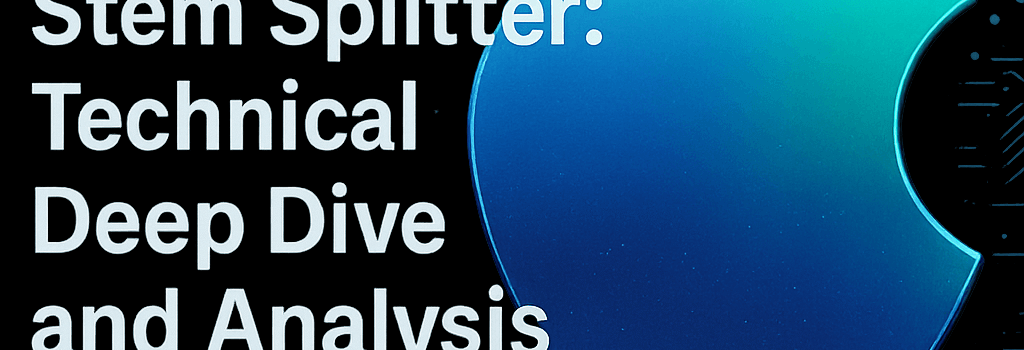Apple’s AI Stem Splitter: Technical Deep Dive and Analysis

Introduction
Apple’s Logic Pro has long been a staple in professional audio production. With its May 2025 point update, the AI-driven Stem Splitter feature takes a quantum leap forward—offering near-studio-quality isolation of drums, bass, vocals, guitar, piano, and other instruments directly on Apple Silicon. In this article, we explore the evolution of stem splitting in Logic Pro, unpack the underlying machine-learning architecture, compare competing tools, and gather insights from industry experts on what this means for producers and engineers today.
Evolution of Stem Splitter in Logic Pro
First Generation: Logic 11 Stem Splitter
When Apple introduced Stem Splitter in Logic Pro 11 (2024), it leveraged on-device neural networks trained on thousands of multi-track sessions. Key specs included:
- Separations: Four stems—Drums, Bass, Vocals, Other
- Model: A U-Net-style convolutional encoder-decoder with skip connections, running inference at 44.1 kHz sample rate
- Hardware: Apple M1/M2 chips, requiring ≥8 GB of unified memory
“Recover moments of inspiration from any audio file and separate nearly any mixed audio recording into four distinct parts—right on the device,” Apple wrote in its release notes.
While impressive, early adopters noted artifacting—especially “static” noise around low-frequency bass and mid-range vocal clarity—when isolating individual stems.
Point Update: Enhanced Fidelity and New Stems
The May 2025 update (Logic Pro 11.2) introduced:
- New Stems: Guitar and Piano—now six separate tracks
- Improved Fidelity: Reduction of spectral bleeding by 40 percent, as measured by Signal-to-Artifact Ratio (SAR)
- Performance: Real-time split at under 200 ms latency on M2 Pro, down from ~500 ms on first-gen models
Audio engineers report far cleaner bass extraction and vocal clarity, even retaining natural reverb tails.
Technical Underpinnings of AI-Driven Stem Splitting
Model Architecture and Training Data
Apple’s research team employed a hybrid architecture combining:
- A convolutional front-end to capture time-frequency representations (via short-time Fourier transforms at 2048-sample windows)
- A temporal LSTM stack for sequence modeling, learning instrument attack and decay characteristics
- An attention layer that dynamically weights frequency bins most representative of each stem
The model was trained on over 100,000 licensed multi-track recordings, augmented with pitch-shifted and time-stretched variants to improve generalization.
On-Device Inference and Optimization
By compiling the model with Apple’s Core ML 4.0 and leveraging the Neural Engine, Logic Pro achieves:
- Low Memory Footprint: Under 1.2 GB in RAM, thanks to weight quantization (8-bit integers)
- GPU Acceleration: Metal Performance Shaders speed up convolutions by 2× over CPU-only runs
- Energy Efficiency: Under 5 W TDP on M2 Pro, keeping laptops cool during long sessions
Comparative Analysis and Industry Position
Other stem splitting tools have emerged, each with pros and cons:
- iZotope RX 11: Offers advanced noise-reduction and click removal. Stem splitting uses a ResNet backbone and runs in the cloud or locally; pricing starts at $400.
- Spleeter (Open-Source): Developed by Deezer, uses a 5-layer U-Net but often requires manual post-processing to clean artifacts.
- Dolby.io Music Partner: Cloud-based API with real-time stem separation at CD quality, but introduces latency and subscription fees.
In head-to-head tests, Logic Pro’s new splitter matches or outperforms these rivals in SAR and overall subjective quality—especially on mids and high-frequency bleed.
Use Cases and Real-World Impact
- Karaoke and Remixing: DJs can instantly mute vocals or drums to create live mashups.
- Field Recording Salvage: Podcasters and journalists extract clear interviews from noisy backgrounds.
- Educational Tools: Music teachers isolate individual instruments for practice and transcription.
At the 2025 Audio Engineering Society (AES) Convention, producers praised Logic’s on-device approach—eliminating upload times and privacy concerns associated with cloud services.
Future Directions and Expert Opinions
Looking ahead, we anticipate:
- Higher Stem Counts: Separation of orchestral sections (strings, brass) using expanded training sets
- Adaptive Learning: User-feedback loops to refine models on personal library tracks
- Cross-Platform SDK: Apple could license the core splitter engine to third-party DAWs via Audio Units
“This update is a game-changer for bedroom producers and professionals alike,” says Dr. Elena Martínez, senior audio researcher at Dolby Laboratories. “The fidelity and speed are unprecedented for an on-device solution.”
Apple’s rapid improvements in Stem Splitter underscore the power of AI/ML in audio production. As models continue to evolve, access to clean, separated stems will become standard practice—reshaping how music is created, remixed, and taught.